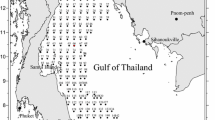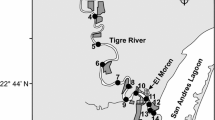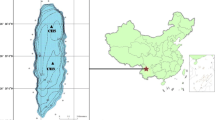Abstract
Eleven cores were collected from the Cauvery basin. Radiometric dates were used to determine modern sediment accumulation rates. Sediment accumulation rates ranged from 0.4 to 4 mm yr−. Heavy metal concentration decreases with the increase of depth. The heavy metal concentrations at certain depths are attributed to the irregular input of metals and their remobilization. Heavy metal accumulations have been computed using sediment accumulation rates, and accumulation rates show an additional anthropogenic input of metals and sediments in the recent past. Factor analysis and correlation analysis show the diverse source and accumulation mechanism influencing the metal distribution in the basin.
Similar content being viewed by others
References
Agnigothrudu V (1985) Agrochemicals use pattern in Cauvery basin. Madras: Madras Science Foundation
Bortelson GC and Lee GF (1972) Recent sedimentary history of Lake Mendota, Wisconsin. Environ Sci Technol 6:798–808
Census (1981) General population tables, Census of India, Part 2-a (i), New Delhi: Directorate of Census Operations. 399 pp
Das BK, Singh M, and Boraker MD (1994) Sediment accumulation rates in the lake of Kumaun Himalaya, India using210Pb and226Ra. Environ Geol 23:114–118
Hakansson K, Karrlsson P, and Allard B (1989) Effects of pH on the accumulation and redistribution of metals in a polluted stream bed sediments. Sci Total Environ 87/88:43–57
Joshi L and Ku KL (1979) Measurement of210Pb from sediment cores of the cost of California. J Radioanal Nuclear Chem 52: 329–334
Kalesha M, Rao KS, and Somayajulu BLK (1980). Deposition rates in Godavari delta. Mar Geol 31: M57-M66
Kemp ALW, Gray GBJ, and Mudrochova A (1972) Changes in the C, N, P and Si in the last 140 years in lake Ontario. In: Alien HE and Karmer JR (eds), Nutrients in natural water. New York: Wiley. pp 251–279
Koide M, Bruland KW, and Goldberg ED (1973) Th-228/Th-232 and210Pb geochronologies in marine and lake sediments. Geochim Cosmochim Acta 37:1171–1187
Krishaswami S, Lal D, Martin JM, and Meybeck M (1971) Geochronology of lake sediments. Earth Planet Sci Lett 11:407–414
Libbey WF (1967) History of radiocarbon dating. Symposium on radioactive dating and methods of low level counting, International Atomic Energy Agency, Monaco, March 1967. Vienna: IAEA, pp 3–26
Lineback JA, Ayers NJ, and Gross DL (1970) Stratigraphy of unconsolidated sediments in the southern part of Lake Michigan. Environ Geol Notes Ill State Geol Surv 35
Meade RH (1982) Sources, sinks and storage of river sediments in the Atlantic drainage of the United States. J Hydrol 90:235–252
Ramanathan AL, Subramanian V, and Vaithyanathan P (1988) Chemical and sediment characteristics of the upper reaches of the Cauvery estuary. Indian Mar Sci 17:114–120
Ramanathan AL, Vaithyanathan P, Subramanian V, and Das BK (1993) Geochemistry of the Cauvery estuary. Estuaries 16(3A): 459–474
Ramanathan AL, Vaithyanathan P, Subramanian V, and Das BK (1994) Solute transport in the Cauvery river basin. Water Resour Res 28(7): 1585–1593
Ramesh R, Subramanian V, and Pillai KC (1988) Sediment and elemental accumulation rates in the Krishna river basin. Sci Total Environ 72:221–226
Sarin MM, Borole DV, and Krishnaswamy S (1979) Geochemistry and geochronology of sediments from the Bay of Bengal and the equitorial. Indian Ocean. Proc Indian Acad Sci 88A:131–154
Seralathan P and Seetharamasamy A (1982) Clay minerals in the Cauvery delta. Indian J Mar Sci 11:167–169
Seralathan P and Seetharamasamy A (1987) Geochemistry of the modern deltaic sediments of the Cauvery river. Indian J Mar Sci 16:31–38
Subramanian V and Mohanachandran GM (1994) Deposition and fluxes of heavy metals in the sediments of the peninsular estuaries of India. Proceeding of heavy metal conference, Plymouth, England (in press)
Subramanian V, Van't Dack L, and Van Griekan R (1985) Preliminary studies on the geochemistry of the Cauvery river basin. Proc Indian Acad Sci 94(2):1–12
Subramanian V, Ramanathan AL, and Vaithyanathan P (1989) Heavy metal distribution and fractionation in the Cauvery estuary. Mar Pollut Bull 21(7):324–340
Author information
Authors and Affiliations
Rights and permissions
About this article
Cite this article
Ramanathan, A.L., Subramanian, V. & Das, B.K. Sediment and heavy metal accumulation in the Cauvery basin. Geo 27, 155–163 (1996). https://doi.org/10.1007/BF00770427
Received:
Accepted:
Issue Date:
DOI: https://doi.org/10.1007/BF00770427




